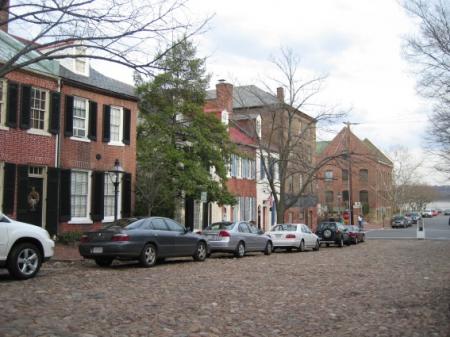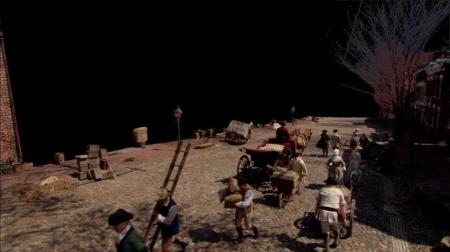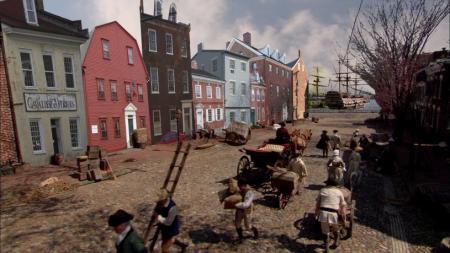Making a Film about Alexander Hamilton
by Muffie Meyer
A few years ago, my colleagues and I made a documentary, Alexander Hamilton, for the Public Television series American Experience. When it was completed, we did a lot of screenings, interviews, and Q&As for all kinds of audiences—including one at the US Treasury for all the (living) former and current secretaries of the treasury. I have compiled the most interesting questions and answers in the form of a "master" Q&A.
Why did you decide to make a film about Hamilton?
It seemed to us (the creative team, composed of Middlemarch Films and Twin Cities Public Television) that Hamilton was one of the least known, least well-understood of the Founding Fathers. An informal poll of reasonably well-educated friends, relatives, and colleagues showed that most people knew very little about Hamilton. They knew about the duel, and a few people remembered The Federalist Papers . . . and that was about it.
Hamilton was an interesting, complicated man who was one of the most influential of the Founding Fathers. He was one of those people who was absolutely brilliant, but whose personality sometimes hindered his ability to be effective. And there was a built-in climax and dramatic ending—always desirable when making a film. We had a man of whom everyone has heard and about whom most people actually know very little. And we had a brilliant but flawed character, a great story, and important themes . . . all of the elements that are needed to make successful film.
What was the most interesting problem you encountered?
The biggest problem we always face in making films set in times before the invention of photography is figuring out what images we will use to fill up two hours of screen time. There simply aren’t enough paintings and drawings. So filmmakers use recreations. Often, these will be scenes from nature that give a sense of both physical and emotional landscapes. But Hamilton was an urban man, so we could not rely on long pans of grasses waving in the wind.
Our major recreations would be of St. Croix and Nevis (for Hamilton’s youth) and New York. Film is very concrete, so every single detail had to be researched.
Sugar cane was the major industry in St. Croix when Hamilton lived there. Where is sugar still cut in the same way as it was in the eighteenth century? We were very lucky to find that in the Dominican Republic, where workers still cut cane by hand with long knives.

Hamilton’s father had left the family and Hamilton’s mother died when he was about 13. We filmed her small funeral procession. What would that have looked like? What kind of cart would have been used to pull her casket? Would it have been pulled by people or animals? All of this required research and educated guesses.
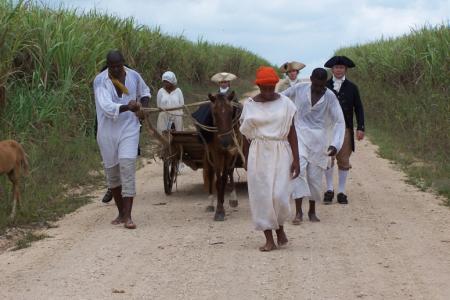
At the age of 14, Hamilton worked at a trading company, and when his employer got sick, Hamilton was left in charge of the business. One of the things that he had to do was to handle a variety of currencies. So for one scene, we imagined him at fourteen, working at a ledger book. What did an eighteenth-century ledger look like? Did it have a cloth cover or a leather cover? Were the pages printed with columns or were the columns hand-drawn? All these things and hundreds more had to be researched and then constructed (or rented from antique shops, sometimes even borrowed from museums).
One of the most interesting problems for me was how to recreate eighteenth-century New York City. There are very few period buildings still extant, and those that are have air conditioners in the windows and modern fixtures on the exteriors, and are surrounded by newer structures.
We needed one big street scene to establish Hamilton’s Manhattan. We had a couple of drawings and paintings that showed some of what New York City looked like. The architecture was wonderfully motley, with stepped Dutch-style roofs, mansard roofs, and gambrel roofs. The streets were mostly cobbled. Our location scout went looking. Philadelphia had cobbled streets surrounded by eighteenth-century houses, but they did not look like those in New York, and location fees in Philadelphia were too costly for our budget. We checked out Baltimore and other places. Eventually, we chose a cobbled street in Alexandria, Virginia, but there were too many trees and the houses looked too uniform. Computer manipulation had just become affordable (for a PBS budget), and we could use the computer to remove trees and replace many of the houses. We sent out our location scout to comb the East Coast to find and photograph buildings that resembled those in the paintings and drawings we had seen.
|
|
|
|
|
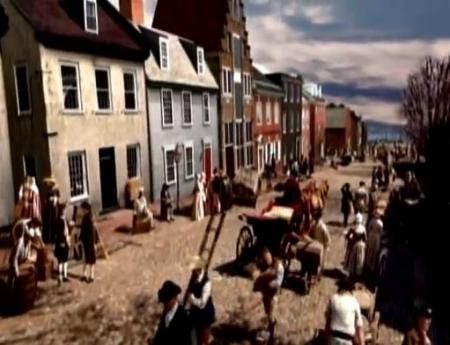 |
How did you cast Hamilton?
We auditioned a great many people for the role of Hamilton before we found Brian O’Byrne. Brian is Irish and has an Irish accent. His American accent was not perfect. Hamilton’s father was Scottish, his mother was French, he grew up in St. Croix surrounded by French and Creole, and he attended Hebrew school. Who knows what his accent would have sounded like? Certainly a mixture of Irish and American would pass.
Beyond the accent, we needed help in coaching the actor. Brian needed to understand Hamilton’s character as deeply as possible. Who was this man? What was he like? What made him tick? One of our advisors, Joanne Freeman, who is probably the person who knows Hamilton better than anyone else in the world, helped us prepare "briefing papers" for Brian. Among the many things we talked about with him to prepare him for playing the role, we emphasized that Hamilton was a man of enormous energy and intense focus. He was someone who believed that reason—a well-reasoned argument, for example—was all that was necessary to convince people of something. As Carol Berkin states in the film,
Politically, he was really sort of the bull in the china shop. I think one of his greatest difficulties was that time and time again he proved he was smarter than other people, and so he could not understand why they didn’t shut up and listen to him. He had very little training in the art of politics as a young man. I mean, think about all of these men of the revolutionary generation. Their fathers were in the colonial legislature, their grandfathers were. Politics was talked about at the dinner table. You heard mistakes that people made. You learned finesse. Hamilton never had that.
Key to understanding Hamilton’s character is the concept of honor—what that meant both to Hamilton and to people in the eighteenth century. To quote Ron Chernow from the film,
It’s hard for us to transport ourselves back to a time in the eighteenth century when everything revolved around birth and breeding and pedigree. I think that the illegitimacy had the most profound effect psychologically on Hamilton. It was considered the most dishonored state, and I think that it produced in Hamilton a lifelong obsession with honor.
Overall, what is the hardest thing you encounter in making films about history?
The most difficult thing is helping the audience to overcome "presentism"—their assumptions that people felt and acted two hundred years ago as they do today. For example, with Hamilton, some people argue that were he alive today he would be a Republican; others claim that he would be a Democrat.
The program sought to show that modern labels simply do not apply. At the end of the Revolution the United States was effectively bankrupt and had a weak and ineffectual central government. Hamilton, chief among the founders, had practical ideas on how to make the country great, ideas about a strong federal government and a strong economy—elements of which are embraced by both liberals and conservatives today. But Hamilton was very much a man of his time. The proof? He was ready to sacrifice his life in a duel for that quaint outmoded concept known as honor.
Why are there so few monuments to Hamilton? They’re even about to take him off the $10 bill!
That he is not acknowledged I think has a lot to do with the fact that he doesn’t talk a lot about the grand ideals: liberty, democracy. He’s really much more about creating policies and institutions. As Carol Berkin and Joanne Freeman put it at the end of the film,
Berkin: I don’t think we like to memorialize people who do practical things. I think the things that Hamilton did don’t fit well on monuments.
Freeman: Hamilton is about the beginnings of systems. He’s someone who has a vision and knows how to put it into effect. It’s really the beginnings of a national government, something that we take for granted, the beginnings of something orderly and powerful and national, something that sometimes we like and sometimes we don’t like so much. But either way, it’s not the sort of person that we stand up and cheer for.
The film’s writer, Ronald Blumer, came up with the idea for a visual metaphor to sum up Hamilton’s contribution. The final shot in the film is a long, slow zoom out from Hamilton’s grave in lower Manhattan to the thriving, modern city around it. The shot was accompanied by the following lines:
The truth of the matter is that we live in Hamilton’s monument—this United States—this is Hamilton’s monument. And when we talk about the American dream, we’re talking about Hamilton’s dream.
Muffie Meyer is a film director who has won major honors for her work, including two Emmy Awards, the Japan Prize, and the George Foster Peabody Award. She is the co-founder of Middlemarch Films, which in 2007 produced Alexander Hamilton, a two-hour documentary for PBS starring Tony Award–winner Brían F. O’Byrne.










































































